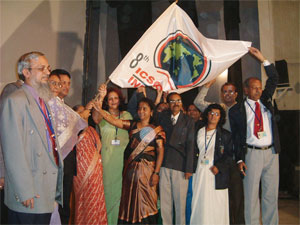 E.U. Shows Productivity Gains, But U.S. Leads World Economy E.U. Shows Productivity Gains, But U.S. Leads World Economy
The European Union, spurred by small gains from its member countries, registered rising productivity in 2004, although it still significantly trails the United States, according to a comprehensive study by The Conference Board.
Productivity in the 25-nation European Union grew from 1.3 percent to 1.6 percent in 2004, and labor input growth increased from -0.2 percent to 0.7 percent. The European Union added 10 new member nations in spring 2004, and figures from The Conference Board show that the 10 new member countries—in Central and Eastern Europe—boosted the European Union’s productivity gains. In those 10 countries, productivity growth averaged more than 4 percent.
But despite its improved performance, the European Union, taken as a whole, still lags behind the United States, which maintained a productivity growth rate of 3.1 percent in 2004. Employment in the United States grew from a 0.1 percent average growth over the last three years to 1.4 percent growth in 2004. On average, the productivity level of the 15-nation European Union (its form before May 2004) was 92 percent of the United States, down from 99 percent in 2000 and 100 percent in 1995. The Conference Board reports that the decline reflects both the relatively slow pace of European productivity growth and the acceleration of U.S. productivity gains after 1995.
“If Europe, the world’s second-largest economy, is going to provide the leadership and drive needed for global prosperity as stated in its Lisbon goals, the 2004 results must be sustained and improved upon,” says Bart van Ark, The Conference Board consulting director and co-author of the report. “Although European GDP [gross domestic product] growth was about 2.3 percent in 2004, this lags behind the growth rates achieved in the U.S. and Japan and is far below the growth rates registered in fast-growing countries such as China and India.”
While the productivity gap between the European Union and the United States was eight percentage points in 2004, the per capita income gap is 28 percentage points. With the exception of Luxembourg, no European country has turned this relatively high productivity into a per capita income higher than that found in the United States. The Conference Board attributes this phenomenon to the fact that European countries have a smaller fraction of the population employed than the United States, and those who are employed generally work fewer hours.
The Conference Board report provides comparable measures of productivity in 97 countries. Labor productivity, which measures output obtained for each hour of work, determines a nation’s living standards as measured by per capita income. The more hours people work and the higher the level of productivity, the higher per capita income.
In other parts of the world, the Japanese recovery continued with productivity growth at 3.6 percent in 2004, following a rebound from 2.7 percent in 2003. The Japanese GDP growth reached 3.9 percent for 2004, up from about 2.7 percent in 2003.
Mexico showed remarkable recovery in productivity and employment growth, posting 2.5 percent and 1.7 percent growth, respectively. This is a strong turnaround, as Mexico posted near zero average productivity growth in 2001 and 2003.
Korean productivity growth was 3.1 percent in 2004—about that of the United States, but with faster employment growth, at 1.8 percent.
In Turkey, the growth in negative hours worked rebounded to a positive growth of 0.6 percent. Turkey showed a huge labor productivity growth rate—9.1 percent—and generated GDP growth above 10 percent, a rate higher than any of the Asian countries.
New Zealand also had a good year, with a 2.6 percent growth rate labor input and productivity gains of 2.1 percent, nearly double that of 2003.
For more information, visit www.conference-board.org.
Errata
In the article, " Six Sigma at National Semiconductor," which appeared in our February 2005 issue, we inadvertently minimized the role of JMP statistical software in National Semiconductor’s Six Sigma process. That article’s sidebar, "Software Selection," should have mentioned that National Semiconductor chose JMP statistical software from SAS for its design of experiments and statistical analysis. JMP integrates nicely with National Semiconductor’s iGrafx Process for Six Sigma process flow and simulation package. We regret the omission.
 Students Meet in Bangladesh for Quality Conference Students Meet in Bangladesh for Quality Conference
More than 800 students met in Bangladesh recently for the annual International Student Quality Control Circles conference.
They came from all over the world—India, Malaysia, Iran, Singapore, Germany and the United States—to participate. The conference focused on the need for including problem-solving skills as part of academics, and students were taught to use analytical techniques and teamwork to solve complicated problems.
With globalization now a reality for manufacturing, nations are competing furiously to outperform the competition. The students were taught that quality excellence built into the national consciousness can provide the edge they need to compete.
Thirty-two papers were presented in a total of 36 team presentations. Forty students took part in the debate competition, while 24 competed in the poster and slogan competition. A.M.M. Khairul Bashar organized the conference, along with the Bangladesh Society for Total Quality Management, Dhaka Residential Model College and the Real Estate & Housing Association of Bangladesh. Quality Digest President Donald L. Dewar was one of the conference’s featured speakers.
The World Council for Total Quality and Excellence in Education sponsored the event. It will next be held Dec. 2–5, 2005, at the City Montessori School & Degree College in Lucknow, India.
Baldrige News
Former U.S. Secretary of Commerce Donald Evans recently appointed four prominent industry leaders to the Malcolm Baldrige National Quality Award panel of judges.
The new judges are Lloyd Barker, Alcoa Inc. director of corporate quality; David C. Branch, Branch-Smith Resources Ltd. chairman and CEO; James R. Evans, Total Quality Management Center director and University of Cincinnati professor of quantitative analysis and operations management; and Steven C. Lampa, Marriott International Corp. senior vice president of lodging quality assurance and rooms operations.
The panel of judges is part of the award’s mostly private-sector board of about 500 examiners who review applications for the Baldrige Award, the nation’s highest award for quality and organizational performance. The judges review examiner comments and scores, select applicants for site visits and recommend Baldrige Award recipients to the Secretary of Commerce.
In other Baldrige-related news, senior executives from the 2004 Baldrige Award winners—The Bama Co., Texas Nameplate Co. Inc., Kenneth W. Monfort College of Business and Robert Wood Johnson University Hospital—will share their best practices and strategies at the Quest for Excellence XVII, April 10–13 in Washington, D.C.
For more information, visit www.baldrige.nist.gov.
Improving Product Development
A new book examines the use of quality methodologies in improving product design processes.
Accelerated Product Development—Combining Lean and Six Sigma for Peak Performance (Productivity Press, 2005), is among the first books to join the concepts of lean and Six Sigma with product development engineering processes outside the shop floor. The book, written by Clifford Fiore, is based on proven strategies and methodologies to help a company reduce time-to-market with its products, reduce product cost, improve quality and combat common product development problems.
For more information, visit www.productivitypress.com.
 Improving Quality in Classrooms Improving Quality in Classrooms
While all school districts strive to deliver high-quality instruction, the meaning of that term varies significantly from one teacher to the next, and from district to district. Because the concept of quality improvement is still relatively new in the field of education, starting a quality improvement effort can prove daunting for teachers and administrators without SPC, Six Sigma or other quality methodology training. Sterling Marshall, assistant superintendent of the Coatesville (Pennsylvania) School District, says that when his district mounted a quality improvement effort, simply defining the terms involved was difficult.
To help in the effort, the district used the Instructional Quality Toolkit from Co-nect, a product specifically designed to aid education industry professionals with quality improvement initiatives.
“Co-nect helped our district staff work together to define quality instruction,” says Marshall. “The tools helped our teachers see where they needed help and we were able to focus professional development on just those areas.”
The IQT is a set of research-based diagnostics, management tools and training resources that help teachers and administrators define, measure and continuously improve the quality of instruction districtwide.
“Districts throughout the country currently mandate teacher evaluations, but the real question is how leaders are helping teachers to improve instruction,” says Andrew Skoler,
Co-nect president and CEO. “Our goal is to get at the heart of teacher quality. In a sense, the required district evaluation serves as the summative review while the IQT serves as a formative benchmark to continuously monitor and improve teaching practices.”
The IQT combines data from classroom practice, teacher perceptions and student work to develop a profile of instructional quality. It generates automated online reports that pinpoint areas of strength and need, and suggests strategies for improving instructional performance. Professional development is focused on building the capacity of district and school leaders to implement the IQT system, interpret data and target training to key areas of need.
It integrates three critical sources of data: Evidence of Quality Teaching, a classroom walkthrough and observation tool; the Instructional Practices Survey, which examines teacher perceptions; and Evidence of Quality Work, a student work analysis tool. The tools are aligned to produce comprehensive reports on classroom teaching. The IQT also includes just-in-time reports and survey instruments commonly used in management to help interpret results. The data may be gathered in three ways: via scannable forms, Web entries or with PDAs.
For more information, visit www.co-nect.com.
facts & figures
By 2008, China will be the single largest semiconductor market in the world, worth about $50 billion a year, according to STMicroelectronics. China is expected to hold 23 percent of the worldwide semiconductor market. The eastern half of the globe, including Asia, will represent 66 percent of the market. The western nations, including Europe and the Americas, are expected to represent just 34 percent of the market.
In a recent study by Best In Class LLC, respondents report that companies on the leading edge of quality look for ways to standardize training for employees who disposition products. One respondent did this by establishing an internal certification program with standardized training modules. The study, called “The Quality Function: Structures, Staffing & Execution,” also found that by recognizing the different roles that auditors play throughout the quality function, benchmark partner companies can more closely align training with the specific needs of a given position. Download a complimentary report at www3.best-in-class.com/rr476.htm.
Chinese Value Quality
A recently published survey shows that quality has a high profile among the Chinese populace.
The survey, which was conducted by the Shanghai Association for Quality and the Shanghai Academy of Quality Management, found that the Public Quality Awareness Index in China is 3.7—“very important.” Respondents also indicated that they are most concerned with product credibility, followed by corporate responsibility and concern.
Almost half of the respondents felt it was “urgent” to improve medical care and transportation services in China, and reported that the improvement should start with quality improvement of existing services.
The study used components of Philip Crosby’s survey methods to rank the findings, and was conducted with 1,335 Shanghai residents and 136 tourists.
The survey sample contained respondents from 46 industries, including food, electronic, automotive, public service, finance, banking, technology, logistics and brokerage.
SAI Global Acquires CRS Registrars
SAI Global recently announced that it has acquired Ohio-based CRS Registrars Inc.
SAI Global, which is based in Sydney, Australia, reports that the transaction will add $5 million in revenue to its U.S. customer base. Additionally, the combination of CRS’ and SAI’s management systems activities in North America will create a business with initial annual revenues approaching $7 million. Terms of the acquisition were not disclosed.
“The acquisition increases our market share and expands our client base in the U.S. significantly,” says Ross Wraight, CEO of SAI.
“Our current intention is to combine our existing North American management systems business with CRS and provide it with access to the resources and synergies that exist across SAI and our U.S. training business, Excel Partnership,” adds SAI Global Chief Operating Officer Tony Scotton.
SAI plans to increase the size of its international offices to handle the increased client base, and current CRS clients will be able to take advantage of the broad base of programs and products available from the new, larger company. The acquisition makes SAI Global one of the top 14 registrars in the United States.
“The transaction will take CRS to the next stage of development combining our strong customer service ethos with SAI’s global audit methodology,” says Bill Niedzwiecki, president of CRS Registrars.
For more information, visit www.sai-global.com.
|